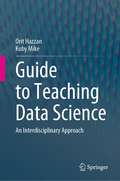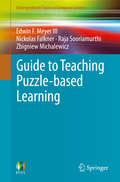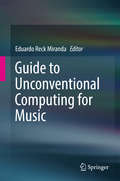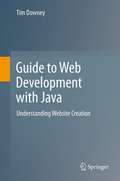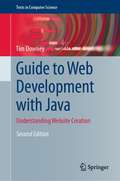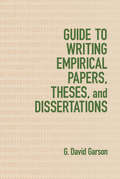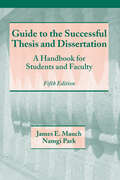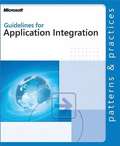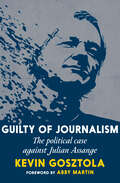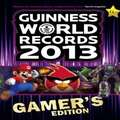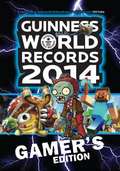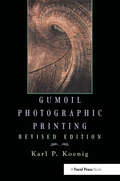- Table View
- List View
Guide to Teaching Computer Science: An Activity-Based Approach
by Tami Lapidot Orit Hazzan Noa RagonisThis concise yet thorough textbook presents an active-learning model for the teaching of computer science. Offering both a conceptual framework and detailed implementation guidelines, the work is designed to support a Methods of Teaching Computer Science (MTCS) course, but may be applied to the teaching of any area of computer science at any level, from elementary school to university. This text is not limited to any specific curriculum or programming language, but instead suggests various options for lesson and syllabus organization.Fully updated and revised, the third edition features more than 40 new activities, bringing the total to more than 150, together with new chapters on computational thinking, data science, and soft concepts and soft skills. This edition also introduces new conceptual frameworks for teaching such as the MERge model, and new formats for the professional development of computer science educators.Topics and features: includes an extensive set of activities, to further support the pedagogical principles outlined in each chapter; discusses educational approaches to computational thinking, how to address soft concepts and skills in a MTCS course, and the pedagogy of data science (NEW); focuses on teaching methods, lab-based teaching, and research in computer science education, as well as on problem-solving strategies; examines how to recognize and address learners’ misconceptions, and the different types of questions teachers can use to vary their teaching methods; provides coverage of assessment, teaching planning, and designing a MTCS course; reviews high school teacher preparation programs, and how prospective teachers can gain experience in teaching computer science.This easy-to-follow textbook and teaching guide will prove invaluable to computer science educators within all frameworks, including university instructors and high school teachers, as well as to instructors of computer science teacher preparation programs.
Guide to Teaching Data Science: An Interdisciplinary Approach
by Orit Hazzan Koby MikeData science is a new field that touches on almost every domain of our lives, and thus it is taught in a variety of environments. Accordingly, the book is suitable for teachers and lecturers in all educational frameworks: K-12, academia and industry.This book aims at closing a significant gap in the literature on the pedagogy of data science. While there are many articles and white papers dealing with the curriculum of data science (i.e., what to teach?), the pedagogical aspect of the field (i.e., how to teach?) is almost neglected. At the same time, the importance of the pedagogical aspects of data science increases as more and more programs are currently open to a variety of people.This book provides a variety of pedagogical discussions and specific teaching methods and frameworks, as well as includes exercises, and guidelines related to many data science concepts (e.g., data thinking and the data science workflow), main machine learning algorithms and concepts (e.g., KNN, SVM, Neural Networks, performance metrics, confusion matrix, and biases) and data science professional topics (e.g., ethics, skills and research approach).Professor Orit Hazzan is a faculty member at the Technion’s Department of Education in Science and Technology since October 2000. Her research focuses on computer science, software engineering and data science education. Within this framework, she studies the cognitive and social processes on the individual, the team and the organization levels, in all kinds of organizations.Dr. Koby Mike is a Ph.D. graduate from the Technion's Department of Education in Science and Technology under the supervision of Professor Orit Hazzan. He continued his post-doc research on data science education at the Bar-Ilan University, and obtained a B.Sc. and an M.Sc. in Electrical Engineering from Tel Aviv University.
Guide to Teaching Puzzle-based Learning
by Edwin F. Meyer Nickolas Falkner Raja Sooriamurthi Zbigniew MichalewiczThis book provides insights drawn from the authors' extensive experience in teaching Puzzle-based Learning. Practical advice is provided for teachers and lecturers evaluating a range of different formats for varying class sizes. Features: suggests numerous entertaining puzzles designed to motivate students to think about framing and solving unstructured problems; discusses models for student engagement, setting up puzzle clubs, hosting a puzzle competition, and warm-up activities; presents an overview of effective teaching approaches used in Puzzle-based Learning, covering a variety of class activities, assignment settings and assessment strategies; examines the issues involved in framing a problem and reviews a range of problem-solving strategies; contains tips for teachers and notes on common student pitfalls throughout the text; provides a collection of puzzle sets for use during a Puzzle-based Learning event, including puzzles that require probabilistic reasoning, and logic and geometry puzzles.
Guide to Three Dimensional Structure and Motion Factorization
by Guanghui Wang Jonathan WuThe problem of structure and motion recovery from image sequences is an important theme in computer vision. Considerable progress has been made in this field during the past two decades, resulting in successful applications in robot navigation, augmented reality, industrial inspection, medical image analysis, and digital entertainment, among other areas. However, many of these methods work only for rigid objects and static scenes. The study of non-rigid structure from motion is not only of academic significance, but also has important practical applications in real-world, nonrigid or dynamic scenarios, such as human facial expressions and moving vehicles. This practical guide/reference provides a comprehensive overview of Euclidean structure and motion recovery, with a specific focus on factorization-based algorithms. The book discusses the latest research in this field, including the extension of the factorization algorithm to recover the structure of non-rigid objects, and presents some new algorithms developed by the authors. Readers require no significant knowledge of computer vision, although some background on projective geometry and matrix computation would be beneficial. Topics and features: presents the first systematic study of structure and motion recovery of both rigid and non-rigid objects from images sequences; discusses in depth the theory, techniques, and applications of rigid and non-rigid factorization methods in three dimensional computer vision; examines numerous factorization algorithms, covering affine, perspective and quasi-perspective projection models; provides appendices describing the mathematical principles behind projective geometry, matrix decomposition, least squares, and nonlinear estimation techniques; includes chapter-ending review questions, and a glossary of terms used in the book. This unique text offers practical guidance in real applications and implementations of 3D modeling systems for practitioners in computer vision and pattern recognition, as well as serving as an invaluable source of new algorithms and methodologies for structure and motion recovery for graduate students and researchers.
Guide to UNIX Using Linux, Fourth Edition
by Michael PalmerGuide to UNIX Using Linux, Fourth Edition is updated to include new UNIX/Linux distributions, networking utilities, new UNIX/Linux capabilities, and coverage of both the GNOME and KDE desktops. The large array of commands, utilities, file systems, and other information you learn here applies to any Linux system and most UNIX systems. Within the book four modern Linux operating systems are spotlighted as examples: Fedora, Red Hat Enterprise Linux, SUSE, and Knoppix.
Guide to Unconventional Computing for Music
by Eduardo Reck MirandaThis pioneering text/reference explores how innovative new modes of computation may provide exciting new directions for future developments in the music industry, guiding the reader through the latest research in this emerging, interdisciplinary field. This work includes coverage of electronic music compositions and performances that incorporate unconventional interfacing, hacking and circuit bending. Features: presents an introduction to unconventional computing in music; discusses initiatives involving biophysical electronic music, the work of self-styled silicon luthiers, and the intersection of music and quantum computing; introduces the memristor, a new electronic component with the potential to revolutionize how computers are built; reviews experiments and practical applications of biological memristors in music; describes IMUSIC, an unconventional tone-based programming language, which enables the programming of computers using musical phrases; includes review questions at the end of each chapter.
Guide to Voice and Video over IP
by Lingfen Sun Emmanuel Jammeh Is-Haka Mkwawa Emmanuel IfeachorThis book presents a review of the latest advances in speech and video compression, computer networking protocols, the assessment and monitoring of VoIP quality, and next generation network architectures for multimedia services. The book also concludes with three case studies, each presenting easy-to-follow step-by-step instructions together with challenging hands-on exercises. Features: provides illustrative worked examples and end-of-chapter problems; examines speech and video compression techniques, together with speech and video compression standards; describes the media transport protocols RTP and RTCP, as well as the VoIP signalling protocols SIP and SDP; discusses the concepts of VoIP quality of service and quality of experience; reviews next-generation networks based on the IP multimedia subsystem and mobile VoIP; presents case studies on building a VoIP system based on Asterisk, setting up a mobile VoIP system based on Open IMS and Android mobile, and analysing VoIP protocols and quality.
Guide to Web Development with Java
by Tim DowneyThis comprehensive textbook introduces readers to the three-tiered, Model-View-Controller (MVC) architecture by using Hibernate, JSPs, and Java Servlets. These three technologies all use Java, so that a student with a background in programming will be able to master them with ease, with the end result of being able to create web applications that use MVC, validate user input and save data to a database. Features: presents the many topics of web development in small steps, in an accessible, easy-to-follow style; uses powerful technologies that are freely available on the web to speed up web development, such as JSP, JavaBeans, annotations, JSTL, Java 1.5, Hibernate and Tomcat; discusses HTML, HTML Forms, Cascading Style Sheets and XML; introduces core technologies from the outset, such as the MVC architecture; contains questions and exercises at the end of each chapter, detailed illustrations, chapter summaries, and a glossary; includes examples for accessing common web services.
Guide to Web Development with Java: Understanding Website Creation (Texts in Computer Science)
by Tim DowneyThis comprehensive Guide to Web Development with Java introduces the readers to the three-tiered, Model-View-Controller architecture by using Spring JPA, JSPs, and Spring MVC controllers. These three technologies use Java, so that a student with a background in programming will be able to master them with ease, with the end result of being able to create web applications that use MVC, validate user input,and save data to a database.Topics and features:• Presents web development topics in an accessible, easy-to-follow style, focusing on core information first, and allowing the reader to gain basic understanding before moving forwards• Contains many helpful pedagogical tools for students and lecturers, such as questions and exercises at the end of each chapter, detailed illustrations, chapter summaries, and a glossary• Uses existing powerful technologies that are freely available on the web to speed up web development, such as Spring Boot, Spring MVC, Spring JPA, Hibernate, JSP, JSTL, and Java 1.8• Discusses HTML, HTML forms, and Cascading Style Sheets• Starts with the simplest technology for web development (JSP) and gradually introduces the reader to more complex topics• Introduces core technologies from the outset, such as the Model-View-Controller architecture• Includes examples for accessing common web services• Provides supplementary examples and tutorials
Guide to Wireless Ad Hoc Networks
by Isaac Woungang Subhas Chandra Misra Sudip MisraWireless communication technologies have been undergoing rapid advancements, however there are several challenges that still need to be addressed. This book provides a comprehensive guide on the new ideas and results in the areas of mobile ad hoc networks, sensor networks and other ad hoc and ubiquitous computing systems, all in the wireless communication technology field. Wireless ad hoc networks and ubiquitous computing are explored by leading experts in the field from both academia and industry, with various challenges in diverse environments, standards, routing mechanisms, etc. This comprehensive book features in-depth descriptions of terminologies and concepts related to the diverse subject areas in wireless communication. This wide-ranging text will be a valuable reference for researchers, students, instructors, engineers, and strategists seeking the state of the art in the field.
Guide to Wireless Sensor Networks
by Isaac Woungang Subhas Chandra Misra Sudip MisraWireless communication technologies continue to undergo rapid advancement. In recent years, there has been a steep growth in research in the area of wireless sensor networks (WSNs). In WSNs, communication takes place with the help of spatially distributed, autonomous sensor nodes equipped to sense specific information. WSNs can be found in a variety of both military and civilian applications worldwide. Examples include detecting enemy intrusion on the battlefield, object tracking, habitat monitoring, patient monitoring and fire detection. Sensor networks are emerging as an attractive technology with great promise for the future. However, challenges remain to be addressed in issues relating to coverage and deployment, scalability, quality-of-service, size, computational power, energy efficiency and security. This highly useful guide presents a comprehensive account of the fundamental concepts, new ideas and results in the field of WSNs.
Guide to Writing Empirical Papers, Theses, and Dissertations
by G. David Garson"Describes the quantitative research process--framing analytical questions, developing a comprehensive outline, providing a roadmap for the reader, and accessing indispensable computer and program tools. Supplies end-of-chapter checklists, extensive examples, and biobliographies."
Guide to e-Science
by Lizhe Wang Wei Jie Xiaoyu YangThis guidebook on e-science presents real-world examples of practices and applications, demonstrating how a range of computational technologies and tools can be employed to build essential infrastructures supporting next-generation scientific research. Each chapter provides introductory material on core concepts and principles, as well as descriptions and discussions of relevant e-science methodologies, architectures, tools, systems, services and frameworks. Features: includes contributions from an international selection of preeminent e-science experts and practitioners; discusses use of mainstream grid computing and peer-to-peer grid technology for "open" research and resource sharing in scientific research; presents varied methods for data management in data-intensive research; investigates issues of e-infrastructure interoperability, security, trust and privacy for collaborative research; examines workflow technology for the automation of scientific processes; describes applications of e-science.
Guide to the De-Identification of Personal Health Information
by Khaled El EmamOffering compelling practical and legal reasons why de-identification should be one of the main approaches to protecting patients' privacy, the Guide to the De-Identification of Personal Health Information outlines a proven, risk-based methodology for the de-identification of sensitive health information. It situates and contextualizes this risk-ba
Guide to the Successful Thesis and Dissertation: A Handbook For Students And Faculty, Fifth Edition
by Namgi Park James MauchAugmented with a new bibliography and streamlined appendices, the Guide to the Successful Thesis and Dissertation, Fifth Edition views the valuable addition of references to university research libraries and advanced information on websites, online searches, electronic literature, and other modern computer methods as crucial for the successful completion of any T/D. This popular text guide features new references and computer-oriented resources for every stage in the creation of honors and master's theses and dissertations and refers to current T/D statistics, federal regulations, ethical codes, and copyright issues and legalities involved in information gathering and study conduct.
Guided Flight Discovery: Instrument/Commercial Textbook
by Jeppesen SandersonJeppesen's Guided Flight Discovery Instrument/Commercial textbook provides the most complete explanations of aeronautical concepts for pilots pursuing a instrument rating or commercial certificate. This colorful textbook is your primary source for initial study and review. It includes the Principles of Instrument Flight, The Flight Environment, Instrument Charts and Procedures, Aviation Weather and IFR Flight Operations and Commercial Pilot Operations, as well as an introductory look at Building Professional Experience. The most comprehensive and visually appealing Instrument/Commercial textbook ever! The Instrument/Commercial textbook is your primary source for initial study and review to achieve an instrument rating or commercial pilot certificate. The intuitive organization and colorful presentation of the manual will help you learn quickly from the start. The text contains complete and concise explanations of the advanced concepts and ideas that every instrument and commercial pilot needs to know with the subjects arranged in a logical manner to build upon previously introduced topics. You can expand your knowledge of specific subjects and the world of aviation by exploring the Discovery Insets, which are strategically placed throughout the chapters. To help you understand how your mind and body function while you fly, human factors principles are presented in Human Element Insets. Throughout the manual, concepts that directly relate to FAA test questions are described in FAA Question Insets. To help you effectively review material, key terms are highlighted throughout the text and listed at the end of each section along with a checklist, which summarizes important concepts. Additionally, you can evaluate your understanding of material by completing the associated questions at the end of each section. Jeppesen Part Number JS314520
Guided Randomness in Optimization, Volume 1
by Maurice ClercThe performance of an algorithm used depends on the GNA. This book focuses on the comparison of optimizers, it defines a stress-outcome approach which can be derived all the classic criteria (median, average, etc. ) and other more sophisticated. Source-codes used for the examples are also presented, this allows a reflection on the "superfluous chance," succinctly explaining why and how the stochastic aspect of optimization could be avoided in some cases.
Guidelines for Application Integration
by Microsoft CorporationExtend your existing technology investments--and increase your organization's agility--by integrating disparate applications and data into solutions that work together to meet ever-evolving business needs. This guide defines application integration and describes the requirements, capabilities, and best practices to help you achieve success. It is written for technical decision makers and architects looking for practical recommendations on how to orchestrate an application integration project that puts heterogeneous and legacy applications to work--helping to maximize ROI and organizational responsiveness. PATTERNS & PRACTICES guides are reviewed and approved by Microsoft engineering teams, consultants, partners, and customers--delivering accurate, real-world information that's been technically validated and tested.
Guidelines for Microsoft Office 2010
by Nancy Muir Anita VernoLearning how to use software should be a simple, straightforward, and engaging experience. The book has taken a step-by-step visual approach to teaching the key features of the Office programs, building knowledge in a logical and easy-to-follow way.
Guidelines for Microsoft Office 2013 (Second Edition)
by Anita VernoIn this second edition, Guidelines for Microsoft® Office 2013, we apply those basics to the newest version of the Office suite. As in the first edition, you will find a step-by-step, visual approach that will help you quickly learn the key features of the Office applications, building knowledge in a logical and easy-to-follow way. For every skill, you will have the option of playing a Skills Video to see and hear the steps demonstrated on screen. Structured end-of-chapter and end-of-module activities and projects will help reinforce what you have learned and assess how well you can apply your new skills to realistic work and school situations. As you work through the skills, exercises, and projects in each chapter, you will gain confidence and proficiency.
Guilty of Journalism: The Political Case against Julian Assange
by Kevin GosztolaFrom an acclaimed independent journalist, this carefully-documented analysis of the government&’s case against Julian Assange and its implications for press freedom acts as a crucial, compelling guidebook to Assange&’s upcoming trial.The legal action against Julian Assange is poised to culminate in a trial in the United States in 2023, and this book will help the public understand the proceedings. The establishment media's coverage of WikiLeaks founder Julian Assange's extradition case has focused on his deteriorating health and what CBS News called his &“secret family,&” but most of this coverage failed to detail the complex issues at stake against Assange. Guilty of Journalism outlines how WikiLeaks exposed the reality of American wars, the United States government&’s unprecedented indictment against Assange as a publisher, and the media&’s role in persuading the public to &“shoot the messenger.&”This new book by Kevin Gosztola, who has spent the last decade covering Assange, WikiLeaks, and the wider war on whistleblowers, tells the full story based on testimony from dozens of witnesses. It examines abuses of power by the CIA and the FBI, including a spying operation that targeted Assange&’s family, lawyers, and doctors. Guilty of Journalism offers a balanced and comprehensive perspective on all the events leading up to what press freedom advocates have called the trial of the century.Guilty of Journalism is a joint production of The Censored Press and Seven Stories Press.
Guinness World Records 2013 Gamers Edition
by Guinness World RecordsWelcome to the brand new Guinness World Records Gamer's Edition! Now in its sixth edition, this year's book is completely updated with incredible new records and the very best images from this year's most amazing titles. There are exciting news stories and fascinating nuggets of trivia detailing recent and upcoming developments in the world of gaming, along with Top Ten charts ranking the most impressive scores of the very best gaming achievements. Discover a dazzling array of essential facts and figures about record-breaking videogames and the highest-scoring players. You can also try our entertaining quiz to test just how much you know about the games you love. Other new features include the "Vs" face-off, in which game characters battle one another. There's also "Flashback", bringing you insights from gaming in days gone by. Get to know gaming better with our "How to spot this genre" box, and improve your own playing skills by following our "Power Up!" tips and hints. "Wow" will surprise you with remarkable gaming facts, and get "One Up" on other gamers with this dazzling trivia feature. There are also gaming recommendations, number-based facts, and stunning-looking features about zombies, female gaming icons and game-related movies. Guinness World Records Gamer's 2013 is the ultimate videogame guide!
Guinness World Records 2014 Gamer's Edition
by Guinness World Records LimitedThe Guinness World Records Gamer's Edition is the ultimate guide to videogames. The all-new 2014 book is bursting with news and views from the gaming world, alongside the latest and very best records relating to the world's most popular games. Amazing trivia sits alongside hard facts and top tips on how to achieve greater feats on the games you love. <P><P>This edition brings you: An At A Glance feature on every game spread for those who crave the essential lowdown on each game's genre, characters and strategy. <P><P> A Best of the Rest wrap up all of the games we couldn't squeeze into the other pages, widening the already panoramic scope of the book. <P><P> A Reader's poll that reports back on the most fundamental question you can ask any gamer - what is the greatest videogame of all? <P><P>With a brand-new, visually dynamic design intended to reflect exciting developments in technology, Guinness World Records Gamer's Edition continues to be the world's greatest videogaming almanac!
Gumoil Photographic Printing, Revised Edition
by Karl KoenigThere is renewed interest among art photographers in a number of historic printing techniques because of the remarkable effects they produce. The reader will discover how to create beautifully tinted mono- and polychromatic gum and oil images using the author's version of this 19th century technique. Step-by-step illustrated instructions with directions for further experimentation provide a perfect source for learning this new, yet old, printing technique. Gumoil printing involves contact-printing a positive transparency onto gum-coated paper. Oil paint is then applied and rubbed into nongummed areas of the print. With bleach etching, mono- and polychromatic variations are possible. A chapter on digital printing combines the new and the historic, making this technique even more accessible for the art photographer.
Guns and Crime: The Data Don't Lie
by Mark GiusGuns and Crime: The Data Don’t Lie investigates the ways in which the current data on guns and crime are inadequate and inaccurate. Although the majority of murders in the United States are committed with guns, research on gun ownership, the supply of guns, and the relationship between guns and crime is less thorough than studies done for many other aspects of public safety policy. This book explores the weaknesses in current findings, and extrapolates the implications of policymaking based on these faulty foundations. As the gun debate continues to rage in North America, this text offers a cautionary voice to the discourse—before practitioners and policy makers can create a solution to gun violence, they must first improve the quality of the facts they use to make their case. Intended for criminology, statistics, sociology, and economics students, Guns and Crime is also suitable for interested laypersons and practitioners hoping to better understand the mythos surrounding guns in America.

